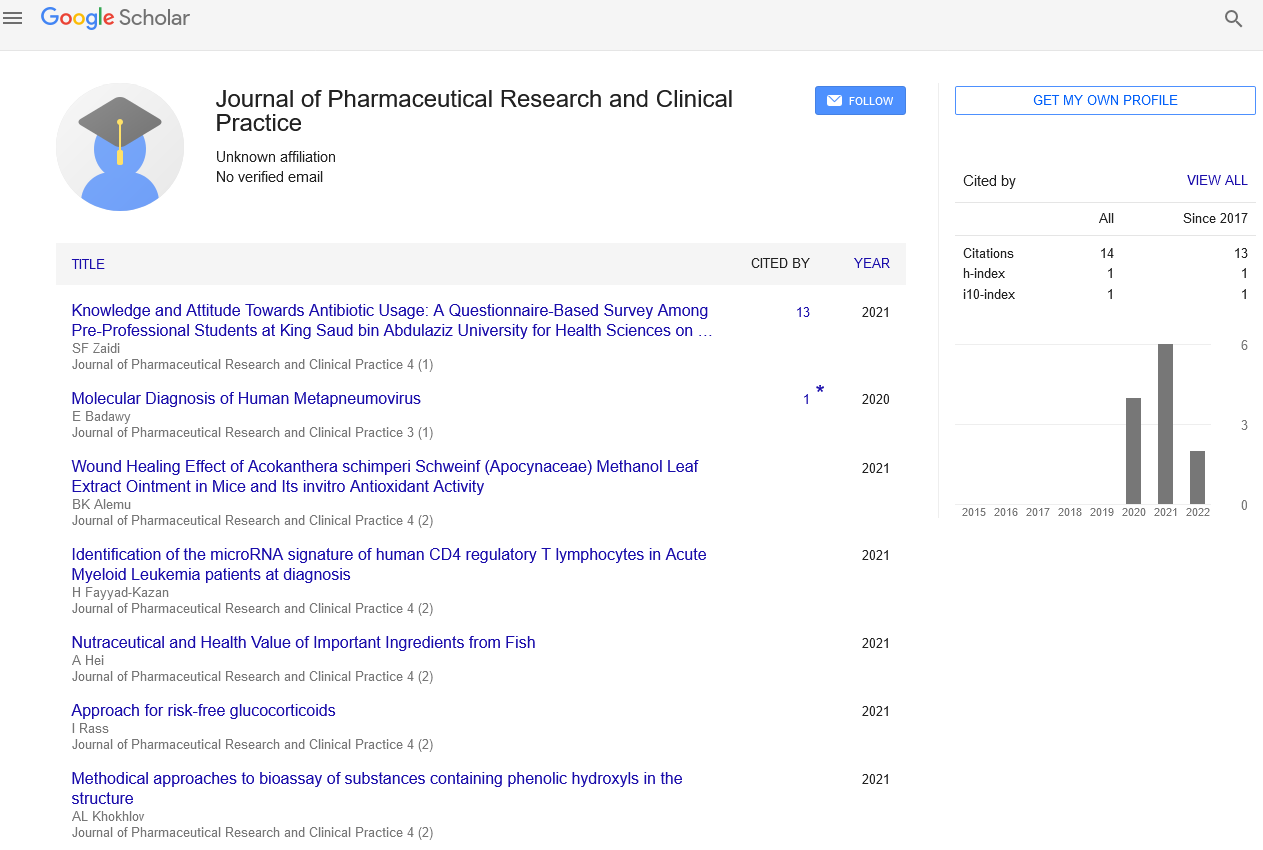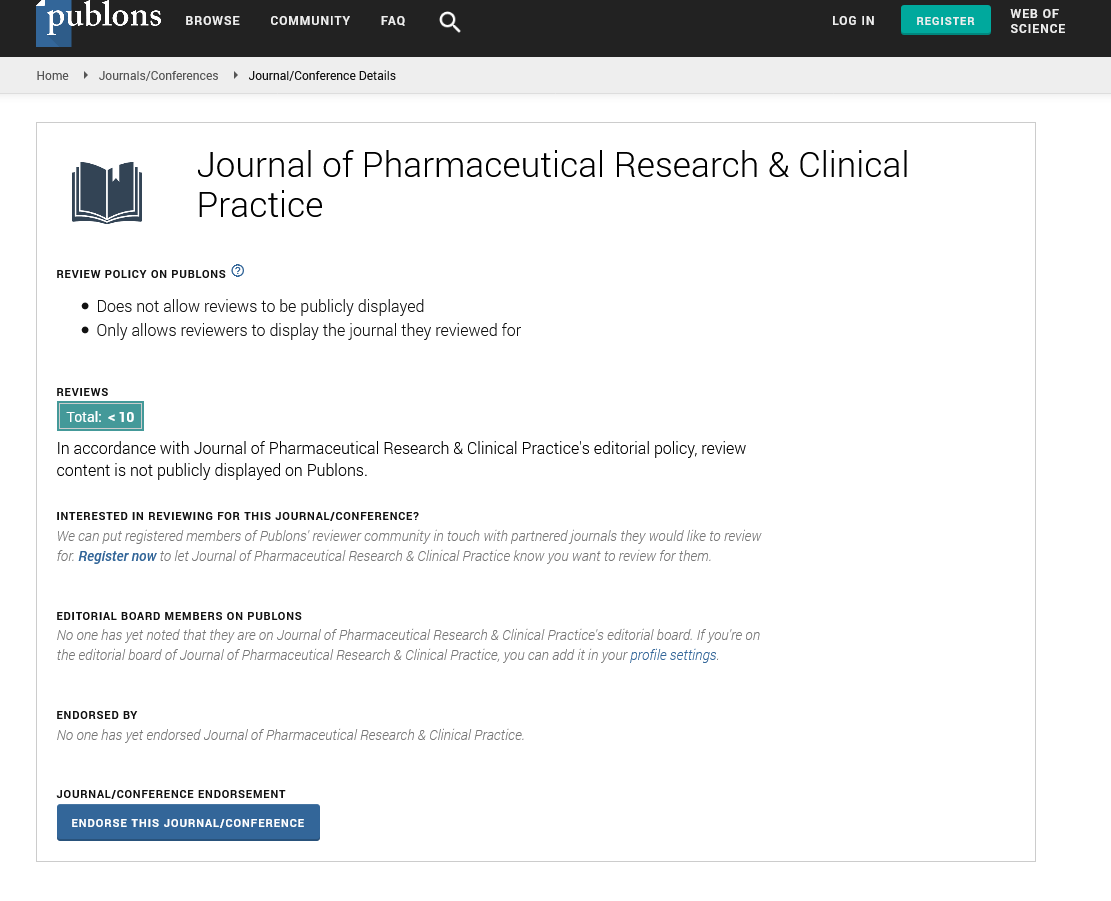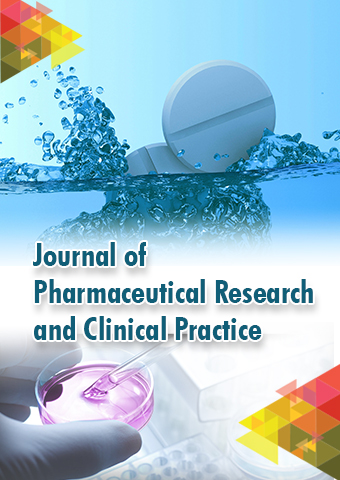Editorial - Journal of Pharmaceutical Research and Clinical Practice (2023) Volume 6, Issue 3
The Art of Diagnosis: Unveiling the Path to Effective Medical Assessment
David Jain*
Department of Clinical Practice, Australia
Department of Clinical Practice, Australia
E-mail: jain_david14@gmail.com
Received: 02-June-2023, Manuscript No. jprcp-23-105657; Editor assigned: 05-Jun-2023, PreQC No. jprcp-23- 105657(PQ); Reviewed: 19-Jun- 2023, QC No. jprcp-23-105657; Revised: 23-Jun-2023, Manuscript No. jprcp-23-105657 (R); Published: 30-Jun-2023; DOI: 10.37532/ jprcp.2023.6(3).74-77
Abstract
The art of diagnosis is a fundamental aspect of modern medicine that serves as the foundation for effective medical assessment and treatment. This article explores the significance of accurate diagnosis, the challenges encountered in the diagnostic process, and the evolving landscape of medical assessment. Accurate diagnosis guides appropriate and timely treatment decisions, empowers patients, and contributes to healthcare planning and research. However, clinicians face challenges such as diverse symptom presentations and limitations of diagnostic tests. Advancements in technology, such as precision medicine and artificial intelligence, are revolutionizing the diagnostic landscape. Ongoing education, interdisciplinary collaborations, and a patient-centered approach are essential for enhancing diagnostic skills. By nurturing the art of diagnosis, healthcare professionals can ensure the provision of personalized, effective care to patients.
Keywords
Art of diagnosis • Effective medical assessment • Accurate diagnosis • Healthcare professional’s • Diagnostic process
Introduction
The art of diagnosis is a skill that lies at the heart of modern medicine, serving as a crucial gateway to effective medical assessment and treatment. It is through the process of diagnosis that healthcare professionals unravel the mysteries behind a patient’s symptoms, uncovering the underlying causes of illness or disease [1]. Comparable to a skilled detective deciphering a complex case, diagnosticians employ their knowledge, experience, and a wide range of diagnostic tools to piece together a comprehensive understanding of a patient’s health condition. In this article, we delve into the realm of the art of diagnosis, shedding light on its immense importance, the challenges encountered along the path to accurate medical assessment, and the ever-evolving landscape of healthcare diagnostics [2]. Accurate diagnosis holds profound significance in the realm of medicine for several reasons. First and foremost, it serves as the foundation upon which appropriate and timely treatment decisions are made. By accurately identifying a patient’s condition, healthcare providers can tailor interventions specific to the underlying cause, optimizing outcomes and minimizing the potential for unnecessary medical procedures or treatments [3]. Furthermore, an accurate diagnosis empowers patients with knowledge and understandings, enabling them to actively participate in their own healthcare journey, make informed decisions, and take necessary steps towards recovery and wellness. Beyond the individual patient level, accurate diagnosis also plays a pivotal role in healthcare planning, resource allocation, and research. The data derived from accurate diagnoses contributes to the overall advancement of medical knowledge, guiding public health initiatives and shaping the future of healthcare delivery [4]. However, the process of diagnosis is not without its challenges. Healthcare professionals often encounter the complex puzzle of diverse symptom presentations, where different diseases or conditions can manifest with similar clinical features. The ability to distinguish between these presentations requires astute clinical acumen, a thorough evaluation of medical history, meticulous physical examination, and the judicious use of laboratory tests and imaging studies. Moreover, certain conditions may present with atypical or vague symptoms, necessitating the clinician to maintain a high index of suspicion and employ specialized diagnostic techniques to uncover the underlying cause [5]. In recent years, advancements in technology have ushered in a new era of medical assessment. Precision medicine, which takes into account an individual’s unique genetic, environmental, and lifestyle factors, holds immense promise in improving diagnostic accuracy [6]. Genetic testing, molecular diagnostics, and the analysis of specific biomarkers now form integral components of the diagnostic process, enabling personalized treatment approaches tailored to an individual’s specific needs. Additionally, artificial intelligence (AI) and machine learning algorithms are revolutionizing the field of diagnosis [7]. These tools have the capacity to analyze vast amounts of patient data, aiding clinicians in pattern recognition, risk prediction, and differential diagnosis. However, it is crucial to strike a delicate balance between the capabilities of AI and the irreplaceable human touch, as the human element remains essential in interpreting complex clinical scenarios and building a strong patientprovider relationship. To enhance diagnostic skills, ongoing education and professional development are paramount [8]. Continuous medical education programs, interdisciplinary collaborations, and the fostering of a culture that encourages open communication and teamwork within healthcare settings are vital for clinicians to stay abreast of the latest diagnostic approaches, refine their clinical reasoning abilities, and improve their diagnostic accuracy. The art of diagnosis serves as the cornerstone of effective medical assessment, providing healthcare professionals with the tools to identify and understand a patient’s condition accurately. Although challenges abound, advancements in technology and the integration of precision medicine and artificial intelligence offer new possibilities for enhancing diagnostic accuracy and transforming healthcare delivery [9]. By nurturing the art of diagnosis through continued education, collaboration, and a patient-centered approach, healthcare professionals can ensure the provision of personalized, effective care that ultimately leads to improved patient outcomes and better overall health for individuals and communities [10].
Material and Methods
Diagnosis forms the foundation of modern medicine, providing a crucial starting point for effective treatment and care. It is the process through which healthcare professionals identify the nature and cause of a patient’s symptoms or condition. Like a detective unraveling clues, skilled diagnosticians employ their knowledge, experience, and a myriad of diagnostic tools to piece together a comprehensive understanding of a patient’s health puzzle. In this article, we delve into the art of diagnosis, exploring its importance, challenges, and the evolving J. Phar. Res. Clin. Pra. (2023) 6(3) landscape of medical assessment.
The importance of accurate diagnosis
Accurate diagnosis is paramount for several reasons. Firstly, it guides appropriate and timely treatment decisions. Proper identification of a condition allows healthcare providers to implement tailored interventions, optimizing patient outcomes and minimizing unnecessary medical procedures or treatments. Secondly, diagnosis empowers patients with knowledge and understanding, enabling them to actively participate in their own healthcare journey. Moreover, an accurate diagnosis plays a pivotal role in healthcare planning, resource allocation, and research, contributing to the overall advancement of medical knowledge.
Challenges in the diagnostic process
The diagnostic process is complex and multifaceted, with various challenges that clinicians must navigate. One of the primary challenges is the sheer diversity of diseases and conditions that can manifest with similar symptoms. This diagnostic “zebra puzzle” demands a careful evaluation of a patient’s medical history, physical examination, laboratory tests, and imaging studies to arrive at an accurate conclusion. Additionally, some conditions present with atypical or vague symptoms, requiring clinicians to maintain a high level of suspicion and employ specialized diagnostic techniques. Another challenge arises from the inherent limitations of diagnostic tests. While modern medicine boasts an impressive array of sophisticated tests, no diagnostic tool is infallible. False-positive and false-negative results can occur, necessitating a nuanced interpretation of test findings in the context of a patient’s clinical presentation. Moreover, diagnostic tests are not equally accessible worldwide, leading to disparities in healthcare delivery and potentially impacting diagnostic accuracy.
The evolving landscape of medical assessment
Advancements in technology are revolutionizing the diagnostic landscape. Precision medicine, which tailors treatment based on an individual’s unique genetic, environmental, and lifestyle factors, holds immense promise for improving diagnostic accuracy. Genetic testing, molecular diagnostics, and biomarker analysis are now integral components of the diagnostic process, enabling personalized treatment approaches. Artificial intelligence (AI) and machine learning algorithms are also transforming diagnosis. These tools can analyze vast amounts of patient data, aiding clinicians in pattern recognition, risk prediction, and differential diagnosis. However, it is essential to strike a balance between the capabilities of AI and the human touch, as the human element remains vital in interpreting complex clinical scenarios and building patient rapport.
Enhancing diagnostic skills
To enhance diagnostic skills, ongoing education and professional development are crucial. Continuous medical education programs and interdisciplinary collaborations provide opportunities for clinicians to stay updated with the latest diagnostic approaches, refine their clinical reasoning, and improve their accuracy. Moreover, fostering a culture that encourages open communication and teamwork within healthcare settings enhances the diagnostic process by facilitating information sharing and collective decision-making.
Discussion
Diagnosis is the cornerstone of effective medical care, enabling clinicians to provide tailored treatment and patients to actively engage in their own well-being. However, the diagnostic process is not without challenges, demanding a combination of clinical acumen, advanced diagnostic tools, and a deep understanding of individual patients. With the rapid advancement of medical technology and the integration of AI, the landscape of medical assessment is evolving, promising to improve diagnostic accuracy and revolutionize healthcare delivery. As we move forward, nurturing the art of diagnosis through continued education, collaboration, and a patient-centered approach will ensure that the journey toward accurate medical assessment remains steadfast.
Conclusion
The art of diagnosis is an essential and intricate aspect of modern medicine, serving as a crucial pathway to effective medical assessment and treatment. Through accurate diagnosis, healthcare professionals can unlock the mysteries behind a patient’s symptoms, enabling tailored interventions and empowering patients to actively engage in their own healthcare journey. However, the diagnostic process is not without its challenges, with diverse symptom presentations and the limitations of diagnostic tools demanding astute clinical acumen and a comprehensive approach. Fortunately, advancements in technology are reshaping the landscape of medical assessment. Precision medicine and the integration of genetic testing, molecular diagnostics, and biomarker analysis offer personalized approaches to diagnosis and treatment. Artificial intelligence and machine learning algorithms assist clinicians in analyzing vast amounts of data, aiding in pattern recognition and risk prediction. However, it is essential to strike a balance between technology and the human element, as the expertise and empathy of healthcare professionals remain paramount. To enhance diagnostic skills, ongoing education, interdisciplinary collaborations, and a patient-centered approach are vital. Continuous professional development programs and a culture of open communication foster the refinement of clinical reasoning and improve diagnostic accuracy. By nurturing the art of diagnosis, healthcare professionals can ensure the delivery of personalized, effective care to patients. In conclusion, the art of diagnosis plays a pivotal role in healthcare, guiding treatment decisions, empowering patients, and contributing to the advancement of medical knowledge. As technology continues to evolve, precision medicine and AI hold promise for improving diagnostic accuracy. However, it is the dedication of healthcare professionals and their commitment to ongoing education and patientcentered care that will truly unveil the path to effective medical assessment. By embracing the art of diagnosis, we can shape a future where accurate diagnoses pave the way for improved patient outcomes and a healthier society as a whole.
References
- Hill-Taylor B, Walsh KA, Stewart Set al.Effectiveness of the STOPP/START (Screening Tool of Older Persons’ potentially inappropriate Prescriptions/Screening Tool to Alert doctors to the Right Treatment) criteria: Systematic review and meta-analysis of randomized controlled studies. J Clin Pharm Ther.41, 158–169(2016).
- Tommelein E, Mehuys E, Petrovic Met al.Potentially inappropriate prescribing in community-dwelling older people across Europe: A systematic literature review. Eur J Clin Pharmacol.71, 1415–1427.
- Prot-Labarthe S, Weil T, Angoulvant Fet al.POPI (Pediatrics: Omission of Prescriptions and Inappropriate prescriptions): Development of a tool to identify inappropriate prescribing. PLoS ONE.9,25-68.
- Corrick F, Conroy S, Sammons Het al.Paediatric Rational Prescribing: A Systematic Review of Assessment Tools. Int. J. Environ. Res. Public Health.17, 1473-1496(2015).
- Sadozai L, Sable S, Le E Rouxet al.International consensus validation of the POPI tool (Pediatrics: Omission of Prescriptions and Inappropriate prescriptions) to identify inappropriate prescribing in pediatrics. PLoS ONE.15, 47-72 (2018).
- Barry E, Moriarty F, Boland Fet al.The PIPc Study-application of indicators of potentially inappropriate prescribing in children (PIPc) to a national prescribing database in Ireland: A cross-sectional prevalence study. BMJ Open.8, 69-556 (2019).
- Van den Anker J, Reed MD, Allegaert Ket al.Developmental Changes inPharmacokineticsand Pharmacodynamics. J. Clin. Pharmacol.58, 10-25(2018).
- Aagaard L.Off-Label and Unlicensed Prescribing of Medicines in Paediatric Populations: Occurrence and Safety Aspects.Clin. Pharmacol. Toxicol.117, 215–218(2015).
- Gore R, Chugh PK, Tripathi CD.Pediatric Off-Label and Unlicensed Drug Use and Its Implications. Curr Clin Pharmacol.12, 18–25(2018).
- Sketris IS. AmericanGeriatricsSociety Beers Criteria Update Expert Panel. AmericanGeriatricsSociety 2019 Updated AGS Beers Criteria for Potentially Inappropriate Medication Use in Older Adults. J Am Geriatr Soc.67, 674–694(2019).
Indexed at, Google Scholar, Crossref
Indexed at, Google Scholar, Crossref
Indexed at, Google Scholar, Crossref
Indexed at, Google Scholar, Crossref
Indexed at, Google Scholar, Crossref


